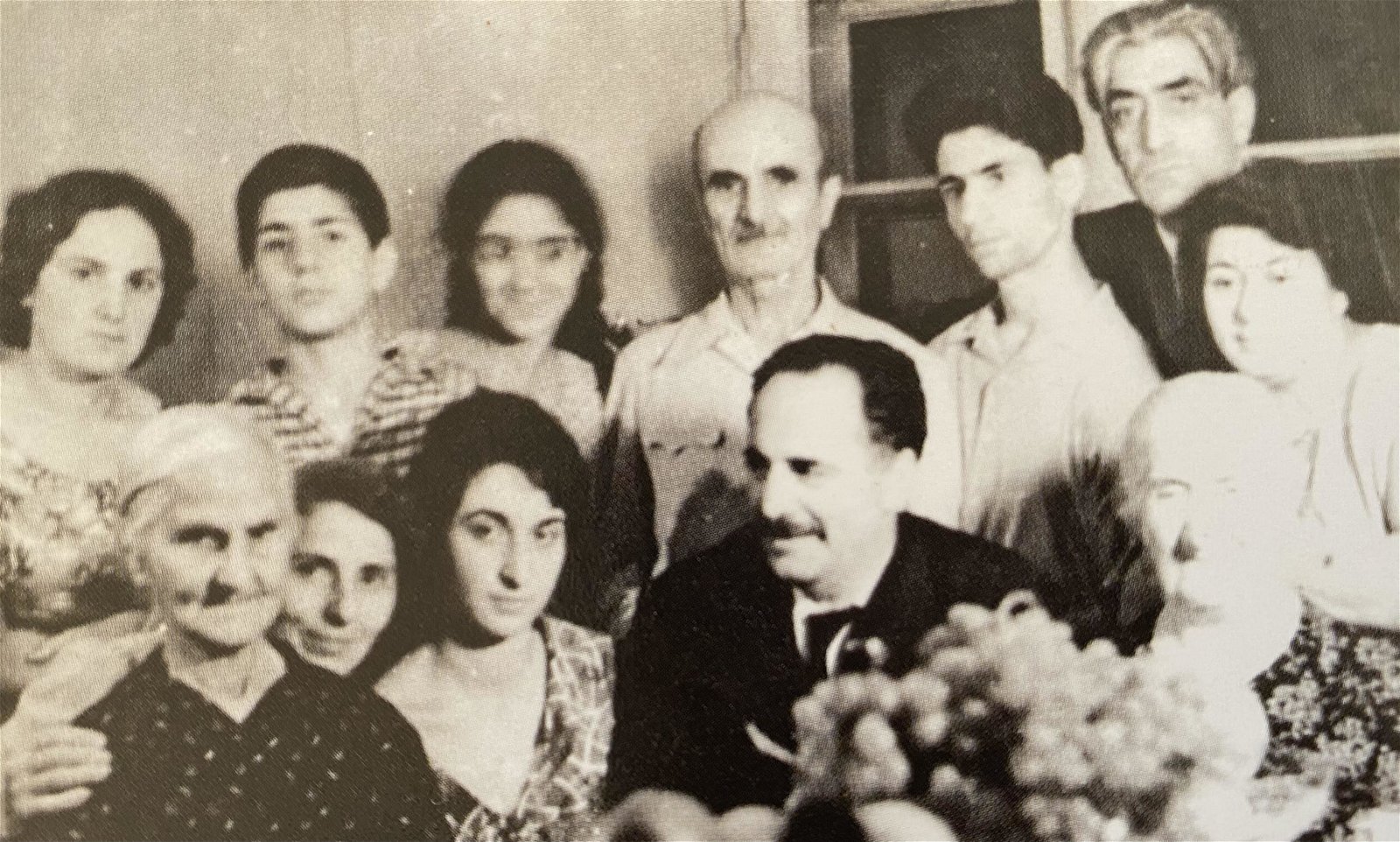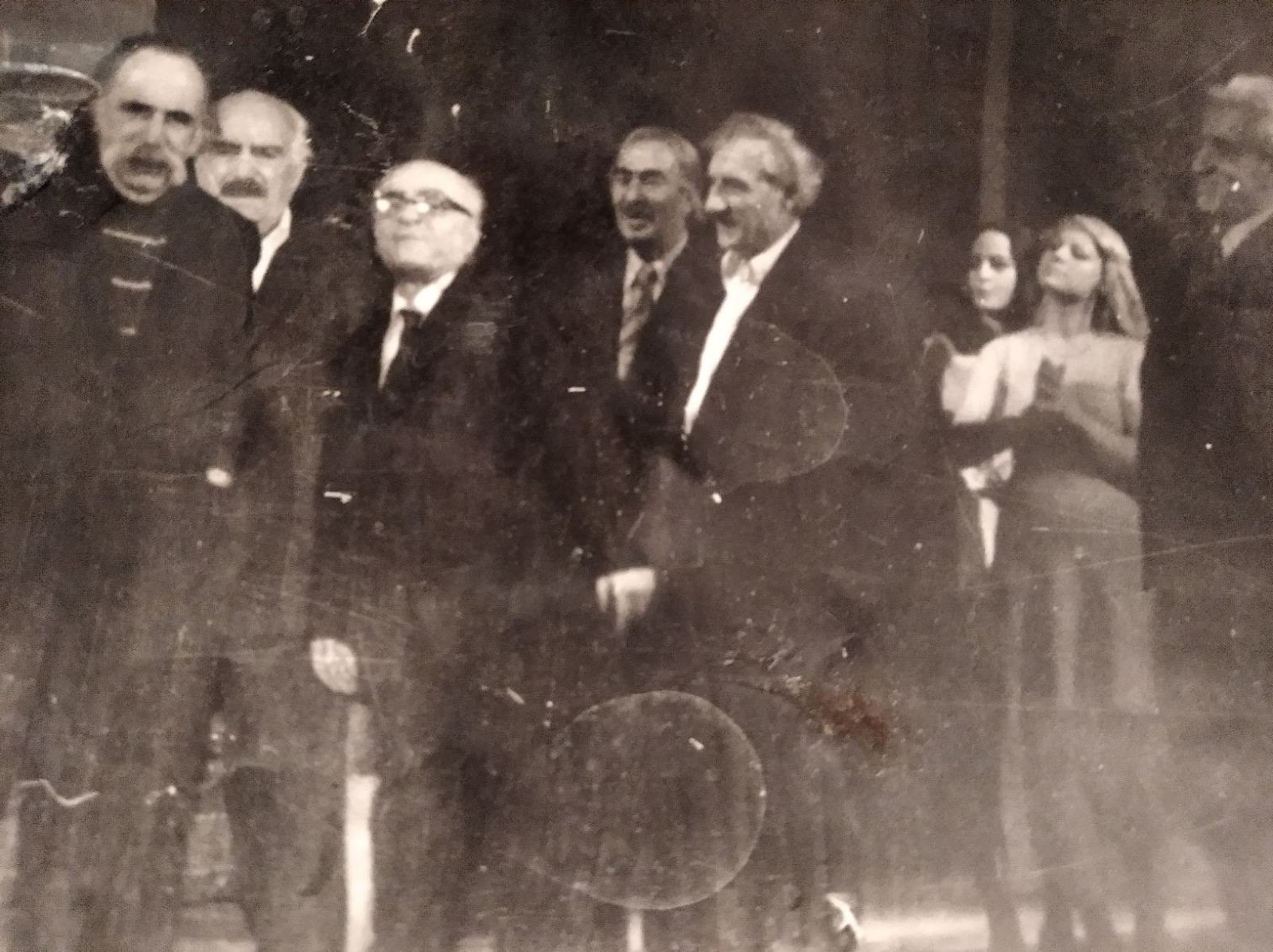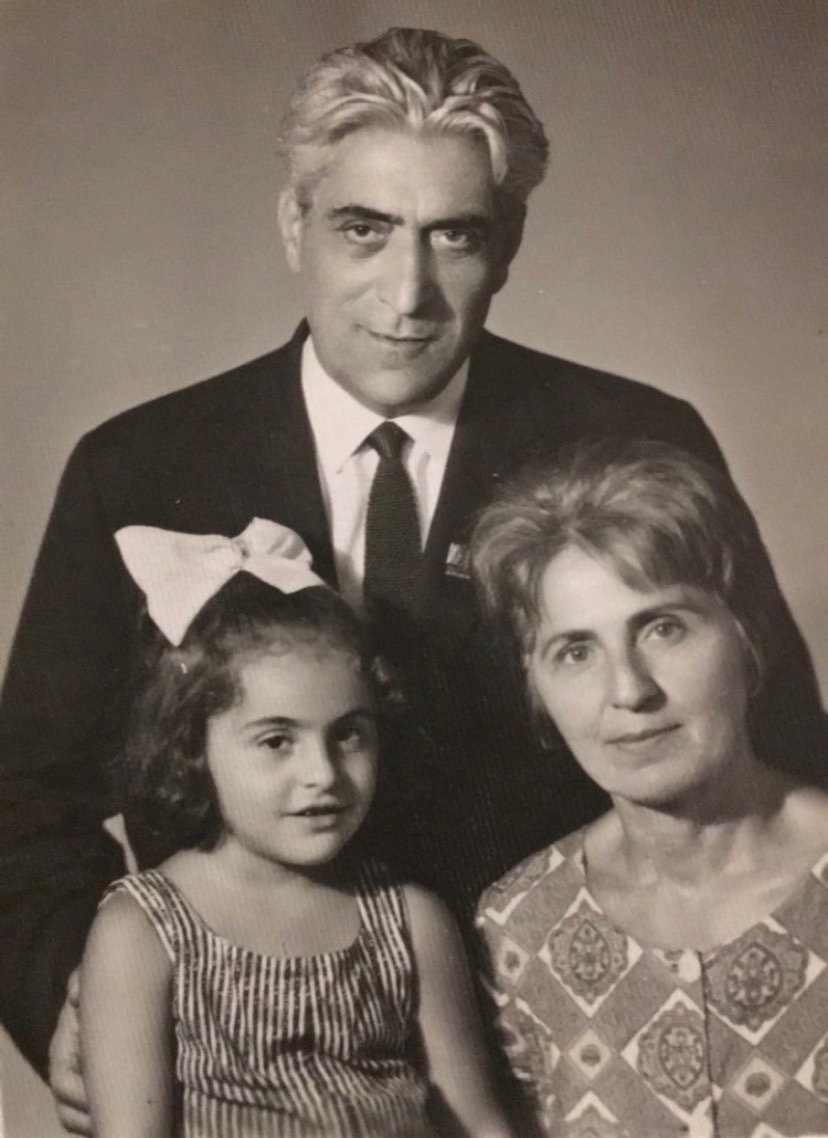
Bottom row from left: The author’s great-great grandmother Khatunik, great grandmother Yeva, grandmother Emma, William Saroyan, great great Bitlisian grandmother Grap.
Top row: Relatives, including the author’s grandmother’s siblings Aram, Seda and Rafael. Her great grandfather Aramashot Papayan is at the top right corner. The photograph was captured by the author’s grandfather Boris Chaghalyan, son of Armenian conductor Emma Tsaturyan.
There once were two little refugee boys living displaced on two different continents. They grew to be tall, lively men from Bitlis, a now occupied former Armenian city. They also became famous writers and ultimately became merely images in my collection of family photographs.
One of those men is my great-grandfather, prominent Armenian playwright Aramashot Papayan. The other is the internationally famous Armenian American writer William Saroyan. My great-grandfather said it best, “I am the smaller Bitlisian, and he is the bigger one.”
They met in 1960 during one of Saroyan’s many visits to Armenia. A famous playwright at the time, Papayan shared the same social circles with people like Silva Kaputikyan, Martiros Saryan and others, so meeting Saroyan wasn’t something significantly out of the ordinary. However, their immediate bond set their friendship apart. That bond was their native familial home of Bitlis.
Neither of them was born there, but their parents had fled the city during the Armenian massacres, which were ensued by the horrifying climax of the 1915 Armenian Genocide. Papayan was born in 1911 in Batumi, Adjara, an autonomous republic in Georgia. Saroyan was born in 1908 in Fresno, California. But to them, Bitlis was their home.
Not only were their family histories rooted in Bitlis, but they later discovered that their parents were likely close neighbors, too. Saroyan would refer to Papayan’s mother, Grap, as a native Bitlisian elder.
“Optimistic, healthy laughter enthuses me,” Papayan once said after turning 85. “It seems to have been infused into my blood as ‘historical memory’ from my Bitlisian ancestors, described by Saroyan as ‘Uncle Arams;’ strong, life-loving, happy, ingenious type of men who gave hard lives a festive air and magical mood.”
Their relationship grew over the years. Saroyan made multiple visits to Armenia, always making sure to spend much of his time with Papayan. “Every time he came to Armenia, he would call me immediately, and we would meet,” said Papayan during a 1996 interview for Aravot newspaper.

In 1976, Saroyan attended a stage production of Papayan’s most successful play, The World, Yes, Turned Upside Down («Աշխարհն այո, շուռ է եկել»), directed by Vardan Adjemian at the Sundukyan State Academic Theater.
Papayan said this play was inspired by Saroyan. He had watched a staging of My Heart is in the Highlands, Saroyan’s Broadway success, and was moved immensely, seeking to write a story about the bliss of Armenians.
“The guests will go and tell others that for Armenians, who went through such tragic sufferings, the world is a wedding now,” said Saroyan after watching Papayan’s hit play.
My mother Karine Chaghalyan met Saroyan at the age of 15 in 1976. Her family was living on Saryan street in Yerevan, Armenia. Saroyan was visiting Papayan, as he always did. She made Saroyan coffee, which he enjoyed on their sofa next to the piano.
During this time, my mother was studying Saroyan’s literature in class. When she told her teacher that Saroyan would be visiting her grandfather that week, the teacher inquired in a surprised tone, “Who?” “Saroyan,” my mother repeated. “Which Saroyan?” her teacher replied. Once the teacher realized that my mother was in fact referring to THE William Saroyan, she eagerly asked her to have the author sign a copy of one of his books for her.
Later that week, my mother bashfully asked Saroyan to sign her teacher’s books. “What is your name?” he asked. “Karine,” my mother replied, too shy to say that the signature was meant for someone else. Somewhere out there, there is a copy of Saroyan’s short stories with “To Karine” scribbled inside.
“Now when I look back I think ‘why didn’t anyone tell me to take a picture with him?’” my mother once told me. “Why did I not ask him to sign a book for me? But then I realized it’s because it was normal for me. Famous people were always in our home. I didn’t understand what it meant to have William Saroyan sitting in your apartment breaking bread with you.”
Saroyan also knew my grandmother Emma Papayan, an actress at Sundukyan State Academic Theater. From restaurants to after-parties, their encounters were rooted in the theater.

Four generations of my family met him, cherished him and admired him. He was the first Armenian writer I ever read. “Here,” my mother would say when I was young. “Read Fresno Stories. Saroyan is one of my favorite writers. Go tell your English teacher that he was your papik’s friend.”
Saroyan is the only Armenian writer I can truly enjoy. Not because other great Armenian writers don’t exist, but because as an American, I can read him in original English text, understand every word and relish in its beauty. Because as an Armenian, I can only be culturally represented by his words in a Eurocentric society.
Loud, tall, fun, eccentric and life-loving, Saroyan and Papayan seemed to have been made for each other. I shudder at the richness of their memories and feel honored on behalf of their societal contributions.
I love Fresno Stories. It feels like home. It’s oddly wonderful to think that I would have met Saroyan too, if writers lived forever.



OT, but Saroyan’s cousin was Ross Bagdasarian, who appeared as the pianist in Alfred Hitchcock’s “Rear Window” – there’s actually a photo of Hitch watering him like a plant – and went on to sing “Witch Doctor” and create Alvin and the Chipmunks. I don’t know whether or not Bagdasarian, being of Armenian descent, ever drew attention to the atrocities committed against the Armenians.
Thank you Ms Partizpanyan for a magical trip down memory lane and for the grainy photographs.
Որպէս խոր հետազօտութեան արդիւնք՝շա՜տ հետաքրքրական ու հիւթալի գրութիւն էք հորինած, օր.Ճեյն: Շնորհաւորութիւններս կը յայտնեմ, անհամբեր սպասելով ձեր գալիք աշխատանքներուն: